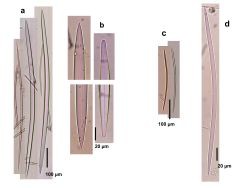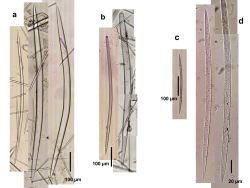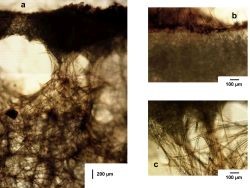orange
orange-yellow
encrusting
lobate
massive
tube
crumbly
tough
Bahamas
Colombia
Myrmekioderma gyroderma
Description: Thick masses with conical or lobed oscular elevations, up to 30 cm or more wide and 5-10 cm high. Oscules single or in groups of 2-3, up to about 1 cm in diameter. Surface traversed by numerous, elongated, meandering grooves of clean tissue (inhalant areas), a few mm wide; ridges in between these grooves are flat at their tops, heavily fouled and with sediments in exposed specimens. Color of the tissue, visible in the oscules and in the grooves, orange-yellow. Consistency toughly compressible, spiculose, but tissues can be torn with some strength. Skeleton as a coarse reticulation of ascending and interconnecting tracks of 2-5 spicules with many spicules strewn in confusion, forming meshes up to about 150-200 µm wide; ascending tracts converge and diverge rather irregularly, becoming strongly confluent near the surface to form a cortex of thick spicule pillars, 125-500 µm wide, separating subsuperficial spaces up to 1250 µm wide. The pillars open up in a dense tangle of confused spicule bouquets that conforms a cortex, some 500 µm thick, mostly made of the smaller spicule type (acanthoxea). The subsuperficial spaces are probably part of the groove’s labyrinth. At the top part of the cortex there are many foreign particles. Spicules in two types: (1) Oxeas I, slightly curved, often with telescopic, slightly asymmetric ends (one end sharp, the other blunt), somewhat slender in material from the Bahamas, much more robust in specimens from the continental coast of Colombia, 630-970 µm long by 6-41 µm wide; a few true styles are present, but appear as modifications of the oxea. (2) Oxeas II, acanthoxea, slightly curved, thoroughly microspined, more strongly in geographical areas where spicules are robust, 200-460 µm long by 5.5-9.3 µm wide
Notes: This is a deep reef species, usually living exposed, although it can occur in walls of reef caves. The species was originally described under the genus Topsentia. It was erroneously know by many Caribbean authors as Myrmekioderma styx (de Laubenfels, 1953), which is a junior synonym of M. rea (de Laubenfels, 1934), a different valid species (also depicted here). It is distinguished from M. rea by its large, stout oxea; the latter has thinner styles-styloids (with a few oxea), and examined specimens from Colombia and Panama have one or more sizes of raphides, usually in trichodragmata, lacking in M. gyroderma. Also, the grooves in M. rea tend to be circular, surrounding rounded elevated areas which become wart-like when the sponge is handled and fixed. Besides, although both species coexist in many localities, M. gyroderma lives on hard exposed substrata on the reef, while M. rea fills reef crevices or dwells buried in sand and rubble in lagoonal settings, although sometimes the latter may be massive and live exposed, as in Martinique and Bocas del Toro (Panama). We have not seen M. gyroderma in the southernmost Caribbean reefs such as those from the NW Gulf of Urabá (Colombia) and Bocas del Toro. In the field, whenever they occur together, Myrmekioderma gyroderma can be confused with Didiscus oxeata, also pictured here. Both have an overall aspect of fouled surface pierced by with orange-yellow grooves, but these tend to be wider and less meandering in D. oxeata, which also has more cylindrical lobes with wide oscular areas on top; the presence of unique discorhab spicules next to stout oxea makesthe latter species distinct.
Author Reference: (Alcolado, 1984)
Link: World Porifera Database

![<i>Myrmekioderma gyroderma</i> <br />[Bahamas, Stirrups Cays, N Berry Islands]](mini/00034/01149.jpg)
![<i>Myrmekioderma gyroderma</i> <br />[Colombia, Islas del Rosario]](mini/00115/01876.jpg)
![<i>Myrmekioderma gyroderma</i> <br />[Colombia, Santa Marta]](mini/00115/01877.jpg)
![<i>Myrmekioderma gyroderma</i> <br />[Colombia, Santa Marta]](mini/00115/01878.jpg)
![<i>Myrmekioderma gyroderma</i> <br />[Colombia, Santa Marta]](mini/00115/01879.jpg)
![<i>Myrmekioderma gyroderma</i> <br />[Colombia, Santa Marta]](mini/00115/01880.jpg)
![<i>Myrmekioderma gyroderma</i> <br />[Colombia, Santa Marta]](mini/00115/01881.jpg)


